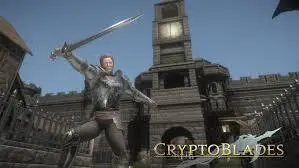The global Web3 market is expected to reach $5.5 billion in 2030, representing an annual compound growth rate (CAGR) of 44.9 percent from 2023 to 2030.
Web 3.0 has transformed various sectors, specifically the gaming industry. In a significant shift from traditional gaming platforms, Web3 games allow players to play using new and innovative methods. Moreover, players can earn cash with NFT games and cryptocurrencies.
Blockchain, Cryptocurrencies, Decentralized Applications (dApps), Smart Contracts, Non-Fungible Tokens (NFTs), and the Semantic Web stand out among these groundbreaking innovations. They’re not just improving our digital experiences but completely reimagining them. It’s hard to believe digital assets can one day hold such significant value, surpassing their physical counterparts.
The emergence of Web 3.0 has introduced new gaming experiences through Web 3 gaming platforms and models, which utilize decentralized technologies. This shift represents more than just a trend—ensuring that Web 3 gaming will continue to shape the industry for years.
What is Web 3.0?
Web3 represents a blockchain-powered internet that facilitates decentralized access for users. Unlike the current model dominated by corporations and government entities, Web3 employs blockchain technology to maintain transaction records that users own.
This decentralized web will feature a variety of user-developed applications, enabling navigation, social networking, and interaction with brands and other users. Using open-source technology, users will regain control over their personal data and web usage, shifting away from today’s centralized model.
Web3 signifies the third iteration of the internet. Here’s a brief overview of its evolution:
Web1:
The first version of the internet, prevalent in the 1990s, was static with minimal user interaction. Although valuable, it lacked algorithms to help users efficiently find information.
Web2:
The second iteration introduced a dynamic web that supports user interactions, content distribution, and sharing on platforms like social media. This is the current version we are using.
Web3:
The upcoming version will integrate technologies such as artificial intelligence (AI) and machine learning (ML) alongside blockchain to deliver highly personalized content to each user. The decentralization aims to mitigate the influence of politically or culturally sensitive content.
Web 3.0 or Web 3 gaming uses blockchain technology to create a more secure and user-centric internet experience. This includes Web 3 gaming platforms and various Web 3 gaming models that provide innovative ways for gamers to engage and interact within decentralized environments.
Market Value of Web 3.0
The Web3 market was valued at $2.86 billion in 2023 and is expected to grow at an annual rate of 44.5%.
North America currently leads the market, accounting for approximately 34% of the global Web3 market share.
By 2030, it is anticipated to reach $49.1 billion globally.
The global blockchain market was worth $17.46 billion in 2023, and its compound annual growth rate (CAGR) is expected to be 87.7% by 2030.
Europe follows closely with 24%, and Asia-Pacific holds 18%.
Additionally, the global market value of the metaverse was estimated at $83.9 billion in 2023, with a projected CAGR of 48% by 2030.
Ready to Build on Blockchain and Web3?
We specialize in creating innovative blockchain and Web3 development solutions. Our expertise extends to Blockchain, Cryptocurrencies, Smart Contracts, Decentralized Apps (dApps), token Semantic Web, and NFT marketplaces. Let’s work together to build the future.
What is Web3 in Gaming?
First-generation games were one-way and static, but later versions were more interactive. Web3 technology has allowed gamers to play online and experience a truly immersive and interactive experience.
Web3 games are digital games that rely on blockchain to store data and pay. Blockchain-based mechanisms have led to massive adoption of concepts like play-to-earn or non-fungible tokens (NFTs). NFTs offer assurance of ownership and smooth trading of digital assets. Furthermore, the play-to-earn model allows gamers to relax and earn cash. These innovations have brought about the realization of Web3 in gaming and transformed it into one of the most invested industries, with billions of dollars poured into it in recent years.
DexiHunter: A New Era of Digital Engagement
DexiHunter is a groundbreaking platform that combines augmented reality with blockchain technology. We designed it to let users easily manage and interact with NFTs, cryptocurrencies, and tokens while experiencing engaging augmented reality environments. More than just a tool for handling digital assets, DexiHunter is a vibrant social platform where users can connect over shared interests and events.
Features of Web 3 Gaming:
In the new Web3 game model, players can buy and sell assets for rewards. Decentralization is the reason for the popularity and pleasure associated with Web3 gaming. Gaming also gains from Web3 in other ways, like improved security. Here are some benefits that are part of Web3 gaming:
Interoperability:
Players can exercise complete control over their assets in the game by using NFTs or Non-Fungible Tokens (NFTs). For Web3 games, interoperability lets investors transfer their investments outside the game’s market. This means that players can market their digital collectibles and not lose funds.
Transparency in the Gaming World:
The Web3 gaming environment is completely autonomous and has little central authority involvement. All the players decide on any changes to the games. Since then, various games have been based on the DAO model, making it easy for players to manage and ward off third parties.
User-Centric Gaming:
The primary goal of Web3 gaming is to give gamers back power. It provides a gaming environment customized to the players’ needs.
Web3 Gaming Use Cases
Web3 provides industries with various opportunities to streamline business processes to transform how consumers purchase products. Let’s see some of the famous use cases that this technology offers:
Blockchain-Based Games:
These games, which use Blockchain technology, can be among the first real-world applications of blockchain technology. They create unique economies where people have their assets. Euphoria XR can be your key to success if you want to incorporate blockchain into your current gaming.
Decentralized autonomous organization (DAO):
A DAO’s members govern it, and no central authority can guide its direction. DAOs adhere to the principles of blockchain, which encourages the community members within them to provide voting rights to their members. Voting rights granted to citizens prioritize their needs over those of influential individuals or groups, constituting a vital governance structure in the gaming community of Web3.
Decentralized Finance (DeFi):
The Web3 platform allows the application of concepts through the decentralized financial system called DeFi. Within the Web3 ecosystem, the financial layer provides for a democratic finance system with no central authority, guaranteeing that no one has the power to modify rules. Euphoria XR specializes in DeFi Meta-Fi, Game-Fi and DeFi.
Metaverse:
The Metaverse is a vibrant, immersive virtual world that showcases some of the most exciting possibilities of Web3 technology. It creates a dynamic environment where users can explore new social interactions and economic opportunities. Euphoria XR leads the way in Metaverse Development Solutions, blockchain integration, DAO governance, and DeFi, offering expert solutions to help you create your virtual worlds.
Factors that Led to the Web3 Revolution in Gaming
Below are Web3 technologies that could be connected to gaming:
Blockchain:
Game developers and gamers can experience the world of gaming by using blockchain technology. The players can enjoy security, decentralization, and much more thanks to this groundbreaking new gameplay method.
NFTs:
Many video games utilize non-fungible tokens (NFTs) to represent ownership rights for the asset used as the base, like virtual land. This can boost gaming and enhance player involvement. NFTs can be transferred between wallets, making digital assets available for trading with sole ownership rights.
Artificial Intelligence (AI):
AI is becoming more popular as a way to increase engagement in traditional games. It increases the speed of interaction and effectiveness and also increases their value.
Tokens:
Tokens in games can attract players. However, if the value of the tokens increases, different aspects of the game might be negatively affected. Because of Internet games, tokens in games can be used to create currencies, which allows gamers to improve their participation and earn a profit.
Augmented Reality (AR) and Virtual Reality (VR):
AR and VR technologies enhance the Metaverse experience by offering more immersive and interactive ways to engage with virtual worlds. VR creates a fully immersive environment where players can connect and socialize through games. At the same time, AR integrates digital elements into the real world, adding layers of virtual information and interaction to physical spaces.
The Most Promising Web3 Gaming Projects
The Web 3.0 gaming landscape is teeming with innovative projects, each vying to shape the future of gaming. Let’s take a look at some of the most exciting and promising projects of 2023:
1. Axie Infinity
Sky Mavis released Axie Infinity in 2018. This NFTs game is the most fantastic Web3 game since it has a sizable community that will stick by it in the event of controversy. The game has a play-to-earn business model on the Ethereum and Ronin blockchains. It is somewhat reminiscent of the Pokemon video games, which feature Axies—creatures that must be trained before engaging in combat. By winning these battles, participants can earn incentives and turn them into crypto assets.
How can I profit?
The Smooth Love Potion, or SLP, needs to be put together by the players. Simply logging in daily, participating in daily adventures, and winning wars will earn you the SLP. You can trade these SLPs for cash or any other cryptocurrency. Breeding and trading axes are different ways to make money with Axie Infinity. On the Axie Marketplace, you can exchange Axes of this breed.
2. The Sandbox
The Sandbox is a Web3 game platform where developers can share and earn money from their voxel assets and gaming creations. It is a decentralized, community-driven gaming ecosystem. This is the appeal of Sandbox: it offers players a blank canvas to explore their creativity and design fun places for other players to visit.

How can I profit?
Players can design unique stuff in the sandbox, which they can later sell as a component of a Web3 game platform. As more players invest money in the game, driving up its value and allowing you to sell it for a profit, owning LAND has the potential to grow your fortune. Sandbox players can also lease their LAND to outside parties, including game developers who do not own it. Another option to gain SAND is participating in tournaments or playing platform games.
3. Ember Sword
Ember Sword is built on countries and a dystopian moon. The landowners can participate in alpha testing, and their website is used for land sales. You can play the game for free or use the play-pay-earn option. The Ethereum blockchain makes it possible to track land ownership and collect NFTs. The in-game currency is Ember, an ERC-20 token that can be bought from within the game. As a result, you can use the token to purchase real estate and collectible in-game NFTs.

4. CryptoBlades
In the Binance Smart Chain (BSC) blockchain-based game CryptoBlades, you must create outfits for characters to participate in combat. It is one of the most well-known cryptocurrency game projects, paying participants more than $3 million daily. The decentralized application (dApp) CryptoBlades has $99.65 million in monthly transaction volume.

How can I profit?
Rewards for winning battles, the sale of characters, and in-game products (NFT) all provide cash for players. You must have a connected Metamask wallet to participate. Before exchanging them for the internal CryptoBlades token, SKILL, the user first purchases BNB coins. With this cash, you can buy people and weapons and carry out all other in-game tasks. Depending on the player’s level, the prize for winning the combat is typically 0.05 SKILL, but it can be more or less. Tokens can be withdrawn, utilized in the game, or exchanged for cash. The 15% withdrawal commission decreases by 1% daily, making it more rewarding to hold onto your tokens.
5. Alien Worlds
Alien Worlds is one of the fastest-growing cryptocurrency games in the decentralized app market, boasting a user base of over 2.7 million players. The game operates simultaneously on three networks—Ethereum, Binance Smart Chain, and WAX. However, WAX, known for its speed and low cost, handles all settlement transactions and technical procedures. As of September 2021, Alien Worlds was processing $5.74 million in large transactions weekly (transactions over $100,000).

How can I profit?
Users can trade various items offered in NFT format and mine TLM, the game’s internal coin. Mining can proceed without active player involvement, as tokens are mined directly into the user’s wallet. The amount you invest initially determines your earnings in Alien Worlds, with potential monthly earnings ranging from tens to several thousand dollars. Additionally, players can stake TLM tokens, though these must be frozen for 48 hours. The game promises future enhancements, including multiplayer battles and team quests.
The Future of Gaming with Web 3.0
The future of gaming with Web 3.0 is poised to be revolutionary, driven by the integration of blockchain technology, decentralized networks, and innovative economic models. Here are some key aspects that will shape the future of gaming in the Web 3.0 era:
Enhanced Player Ownership and Control
In traditional gaming, players often invest significant time and money into games but have little control over their in-game assets. Web 3.0 changes this by providing actual ownership of digital assets through blockchain technology. Players can buy, sell, and trade in-game items as non-fungible tokens (NFTs), ensuring their investments retain value outside the game environment. This shift empowers players, giving them greater control over their gaming experiences and investments.
Interoperability Across Games
Web 3.0 gaming platforms promote interoperability, allowing players to use their assets across different games and platforms. This means you can use a sword won in one game in another, or a character can move between virtual worlds. This smooth integration improves the gaming experience, making it more cohesive and immersive.
Play-to-Earn Models
The play-to-earn (P2E) model has gained significant traction in the Web 3.0 gaming landscape. Players can earn real-world value by participating in games, completing tasks, and achieving milestones. This model democratizes gaming, potentially allowing players from all backgrounds to earn a livelihood through gaming skills. Games like Axie Infinity and Decentraland are already demonstrating the potential of P2E, with players earning substantial income through gameplay.
Decentralized Governance
Web 3.0 introduces decentralized autonomous organizations (DAOs) into the gaming ecosystem. DAOs give players a voice in the development and governance of games. Players can hold governance tokens to vote on game updates, new features, and other critical decisions. This community-driven approach ensures that games evolve in a way that aligns with the players’ interests and preferences.
New Revenue Streams for Developers
Web 3.0 opens up new revenue streams for game developers beyond traditional monetization methods like in-app purchases and advertisements. Developers can create and sell NFTs, implement decentralized finance (DeFi) mechanisms, and build in-game economies that generate ongoing revenue. This shift allows developers to focus more on creating engaging content and less on aggressive monetization strategies that can detract from the player experience.
Enhanced Security and Fairness
Blockchain technology ensures that all transactions and interactions within Web 3.0 games are secure, transparent, and immutable. This enhanced security reduces the risk of fraud and cheating, creating a fairer gaming environment. Players can trust that their assets and achievements are protected and that the game operates with integrity.
Virtual Reality (VR) and Augmented Reality (AR) Integration
Integrating VR and AR with Web 3.0 will take immersive gaming experiences to the next level. Players can interact with their virtual environments in more intuitive and realistic ways. For example, VR headsets can transport players to entirely new worlds to instantly interact with other players and digital assets. AR can bring game elements into the physical world, creating a blend of digital and real-world experiences.
Persistent Virtual Worlds
Web 3.0 will enable the creation of persistent virtual worlds that continue to evolve even when players are not actively participating. These worlds will be governed by smart contracts and DAOs, ensuring they are dynamic and responsive to player actions. This persistence will create a more engaging and continuous gaming experience where players can leave a lasting impact on the virtual world.
Social and Community Building
Web 3.0 gaming platforms will foster stronger social connections and communities. Players can form guilds, collaborate on missions, and participate in community-driven events. The decentralized nature of Web 3.0 will enable more meaningful interactions and collaborations, making gaming a more social and inclusive experience.
Final Remarks!
The rise of Web 3.0 technology is positively impacting the gaming industry. Blockchain and decentralization have opened up new opportunities for game developers and players. Using NFTs, DAOs, and decentralized finance, Web 3.0 reshapes how we play, develop, and monetize games.
The future of gaming is connected to Web3. This technology is not an empty buzzword. It’s an innovation engine that empowers players and changes the gaming industry. With Web 3.0 platforms such as Axie Infinity The Sandbox and Ember Sword already making waves in the gaming world, it’s evident that Web 3.0 gaming will become very popular.
For those interested in exploring the benefits of Web 3.0 gaming, Euphoria XR stands out as a top Web 3.0 Development Company offering innovative services in blockchain, cryptocurrencies, decentralized applications (dApps), smart contracts, and NFTs. For further assistance, Contact Us to discover how Web 3.0 can transform your gaming experience.
















